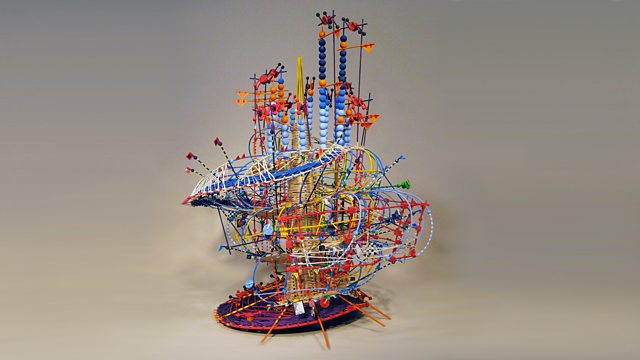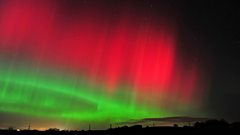The Wind: Its Impact on Earth and in Space
How the wind shapes our environment from the sea to art and outer space.
Wind is all around us, on earth, on the high seas and in a different form, out in space - a powerful force which shapes our environment, and which increasingly we are trying to tame and harness. It is also the stuff or myth and legend around the World.
With Bridget Kendall to explore some aspects of wind, Dr Max Platzer, the distinguished aerospace engineer, once involved in Nasa鈥檚 iconic space launches, who is now focused on how to harvest energy from the powerful winds of the world鈥檚 oceans using a massive fleet of sailing ships with the ability to convert wind energy into hydrogen. Earth and space meteorologist professor Chris Scott from Reading University in the UK tracks the solar winds which come to us from space, to probe how they affect us on earth and has new research linking wind with lightening. And, from Boston in the USA, artist Nathalie Miebach weaves extraordinary sculptures and musical compositions out of storm data she takes from weather stations.
(Photo; The art sculpture Noel Hurricane. Credit: Nathalie Miebach)
Last on
More episodes
Previous
Clip
-
![]()
How the Northern Lights are created
Duration: 00:59
Chris Scott
Chris Scott is Professor of Space and Atmospheric Physics at
the University of Reading.
His research focuses on space weather, with a particular
interest in solar wind and coronal mass ejections but he also talks about wind
and weather patterns here on Earth.
Chris聽聽 has worked for
the Science and Technology Facilities Council in Oxfordshire, leading the Solar
Terrestrial Relations Observatory (STEREO) - Heliospheric Imagers. In
partnership with NASA, Scott coordinated the 2006 launch of the twin STEREO
rockets. The STEREO spacecraft analyse discharge from the Sun. The mission鈥檚
aim was to spot any mass and energy emitted from the Sun which could penetrate
the Earth and interfere with technology. Energy emitted from the Sun,
officially known as coronal mass ejection, is vast clouds of ionised gas. Each
CME may carry 1,000,000,000 tonnes of gas into space at speeds that can
approach 2000 km/s. CME disrupts the flow of solar wind. The two STEREO
spacecraft circle the Sun, gathering images.
In 2014 Chris lead research in solar winds and lightning.
His research, published in the Journal of Environmental Letter, suggested that
solar winds can increase lightening on Earth.聽
Nathalie Miebach
Nathalie Miebach is a Boston based artist who converts
ecological data into complex music and sculptures.聽
When she studied physics and astronomy she found herself
fascinated, especially by astronomy and wanted to learn more. Her interest in
space was quickly hampered by her inability to go out and actually experience it.
So she decided to use the weather, somewhat influenced by activity in space, as
a new way to channel her creative impulses. In 2000 Nathalie first started
using meteorological data to produce art. For four years she collected weather
data and created complex helix sculptures and installations. Despite being
unable to read music, in 2009 Nathalie started to use the same data to produce
musical scores. She works in collaboration with a collection of musicians and
composers. Her sculptures therefore act as both visual works of art, and
musical notations and she is interested in how art can represent science in
interesting and intriguing ways and also how science might learn from artistic
interpretation.
Max Platzer
Professor Max Platzer is a mechanical and aerospace
engineer. In 1995 Professor Platzer was made Distinguished Professor Emeritus
at the Naval Postgraduate School in Monterey, California. He taught aeronautics
and astronautics at the institution for more than thirty four years. He聽 is Adjunct Associate Professor at the
University of California Davis.
Professor Platzer鈥檚 research interests are relatively
widespread. His studies focus on: fluid mechanics; gas dynamics;
aeroelasticity; flight mechanics; aerodynamics and propulsion.
Professor Platzer has enjoyed a long and respectable carer
in academia. However his early career contained some significant work for NASA.
Platzer spent six years working with renowned German engineer, Wernher von
Braun. There, Platzer helped to develop the Saturn-V rocket. The Saturn-V (pro
Saturn 5) was in use by the Americans from 1966-73. It launched SkyLab, the
first American space station, and supported Apollo 17 in early exploration of
the moon. He is also a Fellow of the American Institute of Aeronautics and Astronautics.
Professor Platzer,聽now in his 80s, has developed an idea to create a huge fleet of sailing
ships with the ability to harvest ocean winds and convert this wind energy into
electricity聽 and then into hydrogen, on
board the ships. He believes it could be a聽major provider of The World鈥檚 energy and help to tackle many
environmental challenges.
60 Second Idea to Change the World

Nathalie Meibach wants to get people all over the world to
collect the sounds, smells and tastes of weather and bring them all together to
be shared in the first Weather Library of the Planet.
This library would be useful for the general public, the
scientific community and humanity as a whole in gaining a more nuanced,
sensuous awareness of the interconnectedness of weather systems all over the
world.
Photo: a detail from the sculpture 'In the Shadow of the Giant' by Nathalie Miebach
Broadcasts
- Mon 28 Sep 2015 01:06GMT91热爆 World Service except Australasia & West and Central Africa
- Tue 29 Sep 2015 08:06GMT91热爆 World Service
- Wed 30 Sep 2015 01:06GMT91热爆 World Service Australasia
Do you think political or business leaders need to be charismatic? Or do you prefer highly competent but somewhat stern people?
Podcast
-
![]()
The Forum
The programme that explains the present by exploring the past




